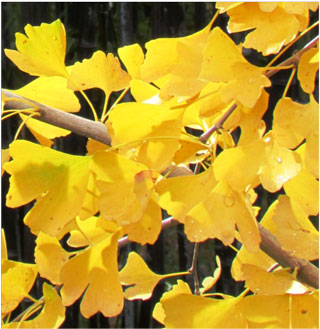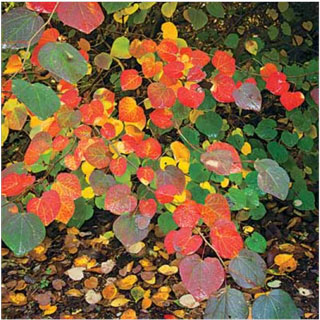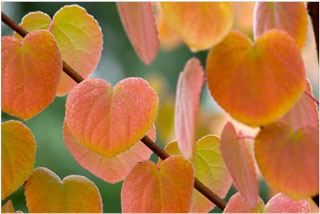I’m often asked which trees or shrubs to plant for best fall foliage color here in Connecticut. So here’s my list of the 10 trees that I think look best in autumn.
Sugar Maple Tree (Acer Saccharum)
 This is the quintessential New England tree and one of the most common maples in Connecticut, where hillsides of them turn gorgeous shades of red, orange, and yellow in autumn. These are the maples from which maple syrup is made (a grove of sugar maples that have been tapped to collect sap is referred to as a sugar bush). Sugar maples grow up to 75 feet tall and 40 feet wide. If your yard can’t handle that, consider other kinds of maples that also have strikingly colorful leaves in fall, including vine maple (Acer circinatum), native to the Northwest, and the smaller Japanese maple (Acer palmatum). Avoid invasive types, including Amur (Acer ginnala) and Norway (Acer platanoides) maples.
This is the quintessential New England tree and one of the most common maples in Connecticut, where hillsides of them turn gorgeous shades of red, orange, and yellow in autumn. These are the maples from which maple syrup is made (a grove of sugar maples that have been tapped to collect sap is referred to as a sugar bush). Sugar maples grow up to 75 feet tall and 40 feet wide. If your yard can’t handle that, consider other kinds of maples that also have strikingly colorful leaves in fall, including vine maple (Acer circinatum), native to the Northwest, and the smaller Japanese maple (Acer palmatum). Avoid invasive types, including Amur (Acer ginnala) and Norway (Acer platanoides) maples.
Maidenhair Tree (Ginkgo Biloba)
 Gingkos put on a spectacular yellow show in fall. Considered living fossils because they are the last survivors of tree varieties that grew worldwide 270 million years ago, gingkos are related to conifers but have fan-shaped leaves rather than needles. The leaves resemble those of the maidenhair fern, thus the common name: maidenhair tree. Trees often have an umbrella shape and can grow 80 feet tall, though many stay only half that height. I’d suggest planting a male ginko tree as the fruit of the female trees give off a strong smell that many find unpleasant.
Gingkos put on a spectacular yellow show in fall. Considered living fossils because they are the last survivors of tree varieties that grew worldwide 270 million years ago, gingkos are related to conifers but have fan-shaped leaves rather than needles. The leaves resemble those of the maidenhair fern, thus the common name: maidenhair tree. Trees often have an umbrella shape and can grow 80 feet tall, though many stay only half that height. I’d suggest planting a male ginko tree as the fruit of the female trees give off a strong smell that many find unpleasant.
Eastern Redbud Tree (Cercis Canadensis)
 Despite its name, this small tree bears bright pinkish-purple spring flowers directly on the branches before its heart-shaped leaves appear. Most varieties turn yellow in autumn; the eastern redbud ‘Forest Pansy’ is one of the few with reddish-purple fall foliage. In winter, long mahogany seed pods cling to bare branches. The eastern redbud is more common and adaptable than the western natives (Cercis occidentalis and Cercis canadensis mexicana), though the latter are very drought tolerant. Due to its varied seasonal interest and its ability to grow in light shade, redbud provides a great contrast next to evergreens. Eastern kinds grow to 35 feet; western types to about half that.
Despite its name, this small tree bears bright pinkish-purple spring flowers directly on the branches before its heart-shaped leaves appear. Most varieties turn yellow in autumn; the eastern redbud ‘Forest Pansy’ is one of the few with reddish-purple fall foliage. In winter, long mahogany seed pods cling to bare branches. The eastern redbud is more common and adaptable than the western natives (Cercis occidentalis and Cercis canadensis mexicana), though the latter are very drought tolerant. Due to its varied seasonal interest and its ability to grow in light shade, redbud provides a great contrast next to evergreens. Eastern kinds grow to 35 feet; western types to about half that.
Katsura Tree (Cercidiphyllum japonicium)
 With dainty branches that become dense with rounded leaves, katsuras make great shade trees all summer, then put on a show of yellow or pinkish yellow in fall. Around the time leaves fall, the tree produces a fragrance that some call spicy; others compare it to brown sugar. Most katsuras have a pyramid shape when young but over time may become as wide as they are tall (up to 60 feet). There are also weeping forms, such as ‘Amazing Grace,’ that look particularly beautiful when the branches are bare in winter.
With dainty branches that become dense with rounded leaves, katsuras make great shade trees all summer, then put on a show of yellow or pinkish yellow in fall. Around the time leaves fall, the tree produces a fragrance that some call spicy; others compare it to brown sugar. Most katsuras have a pyramid shape when young but over time may become as wide as they are tall (up to 60 feet). There are also weeping forms, such as ‘Amazing Grace,’ that look particularly beautiful when the branches are bare in winter.
Smoke Bush (Cotinus coggygria)
 Also known as smoketree, this plant can be allowed to grow as a shrub or be pruned as a small tree. Small yellow flowers open in June. As they fade, long stalks with fuzzy pink hairs spring out, creating the impression that the plant is surrounded by purple to pinkish-tan smoke. These fade away by fall, when the leaves turn yellow or orange-red. ‘Royal Purple’ has purple foliage that turns scarlet red; ‘Ancot’ has lime-green leaves that go orange.
Also known as smoketree, this plant can be allowed to grow as a shrub or be pruned as a small tree. Small yellow flowers open in June. As they fade, long stalks with fuzzy pink hairs spring out, creating the impression that the plant is surrounded by purple to pinkish-tan smoke. These fade away by fall, when the leaves turn yellow or orange-red. ‘Royal Purple’ has purple foliage that turns scarlet red; ‘Ancot’ has lime-green leaves that go orange.
Baldcypress (Taxodium distichum)
The baldcypress isn’t on most people’s top 10 list but it has the unique distinction of being a deciduous conifer (it loses its needle-like leaves in autumn) and puts on a majestic fall display of orange red color. This tree can be found throughout most of the United States.
Black Tupelo (Nyssa sylvatica)
 Black tupelo is one of the least known trees in Connecticut, probably because it tends to grow in, or bordering, wet areas in remote areas. It does make a wonderful shade tree though and is well worth planting. Known for its spectacular fall foliage, the Black Tupelo can contain many shades of color on the same branch. Frequent colors seen on the leaves of this autumn beauty include yellow, orange, bright red, purple, and scarlet. This tree also bears fruit that birds like and will grow up to 50’ tall.
Black tupelo is one of the least known trees in Connecticut, probably because it tends to grow in, or bordering, wet areas in remote areas. It does make a wonderful shade tree though and is well worth planting. Known for its spectacular fall foliage, the Black Tupelo can contain many shades of color on the same branch. Frequent colors seen on the leaves of this autumn beauty include yellow, orange, bright red, purple, and scarlet. This tree also bears fruit that birds like and will grow up to 50’ tall.
Sweet Gum Tree (Liquidambar styraciflua)
 Often confused with a maple tree because of the similar-looking leaves, sweet gum’s star-shape leaves turn a kaleidoscope of colors in fall, including red, orange, and burgundy — giving the landscape a carnival feel at season’s end. Sweet gum trees also produce a spine-covered, hard fruit (called a sweet gum ball) in fall that many homeowners find annoying when they drop all over the ground. It’s probably best to plant this beautiful tree away from driveways, decks, and walkways.
Often confused with a maple tree because of the similar-looking leaves, sweet gum’s star-shape leaves turn a kaleidoscope of colors in fall, including red, orange, and burgundy — giving the landscape a carnival feel at season’s end. Sweet gum trees also produce a spine-covered, hard fruit (called a sweet gum ball) in fall that many homeowners find annoying when they drop all over the ground. It’s probably best to plant this beautiful tree away from driveways, decks, and walkways.
Scarlet Oak (Quercus coccinea)
 Scarlet oaks are a symbol of strength and beauty here in Connecticut with their 60 to 80 foot canopies. While the leaves on most oak trees simply turn brown or yellowish in autumn, the leaves of Scarlet Oak are one of the most colorful contributors to the fall foliage display, turning bright red before falling. Aside from the brilliant fall color, you’ll also recognize scarlet oak by the more narrow and sharply pointed leaves.
Scarlet oaks are a symbol of strength and beauty here in Connecticut with their 60 to 80 foot canopies. While the leaves on most oak trees simply turn brown or yellowish in autumn, the leaves of Scarlet Oak are one of the most colorful contributors to the fall foliage display, turning bright red before falling. Aside from the brilliant fall color, you’ll also recognize scarlet oak by the more narrow and sharply pointed leaves.
Burning Bush (Euonymus alatus)
 I hesitate to add burning bush to this list because it’s classified as an invasive plant here in Connecticut (meaning that it’s illegal to propagate, plant, or transport it). Still, if you already have one of these large shrubs (it can grow to 15 feet tall) in your yard, you’ll appreciate the magnificent fiery red fall foliage. Just be sure to keep it in check with frequent pruning and, if you can, prevent it from bearing fruit (or cut off the berries before they ripen) as these are easily spread by birds.
I hesitate to add burning bush to this list because it’s classified as an invasive plant here in Connecticut (meaning that it’s illegal to propagate, plant, or transport it). Still, if you already have one of these large shrubs (it can grow to 15 feet tall) in your yard, you’ll appreciate the magnificent fiery red fall foliage. Just be sure to keep it in check with frequent pruning and, if you can, prevent it from bearing fruit (or cut off the berries before they ripen) as these are easily spread by birds.
If you’d like to know why leaves turn color in fall, check out our explanation here.




